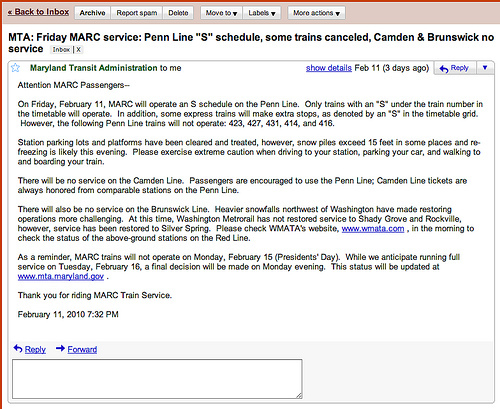Emails with links a recipe for WMATA site overload
Over the past week, Metro has seen a number of major service disruptions, mainly due to the heavy snowfall. But WMATA’s method of communicating over email, which sends messages with only a link to a page on WMATA.com instead of the text of the announcement, turned out to be useless when too many people tried to view the release.
Thursday evening, the Office of Personnel Management announced that government workers would be expected in the office on Friday. WMATA announced its plans for the region, including limited service on the Red and Orange Lines. The volume of traffic seeking out this information overwhelmed WMATA’s servers, and many were unable to get vital information. That led Greater Greater Washington to mirror the service information for readers.
What’s the problem? WMATA sends out press releases like this one:
With no service information, riders are forced to click for additional information. If the website is inaccessible, riders are out of luck. Furthermore, it forces riders to have an Internet connection, when many with Blackberries or similar devices might have the email but reduced ability to load the page.
When a train derailed at Farragut North on Friday, WMATA sent out a release with the title, “Metro News: Derailment reported at Farragut North Metrorail station.” Unfortunately, I was unable at the time to get to the website to read the full text. Was the station open? Were they single-tracking? When was normal service expected to resume? Not for 47 minutes did WMATA send out a second release, this one titled “Derailment at Farragut North Metrorail station: station closed.”
Compare how MTA sends out information to MARC commuter train riders:
People who get this press release don’t need to swarm MTA’s servers. The information they need is in their inbox. Even if MTA’s servers go down, commuters have to only go so far as their email service to know where trains are running and any other pertinent information.
Ken Archer sent in a tip this morning that when he’d tried to access it, the WMATA site was again down. WMATA could beef up their website capacity, but the best solution would be to include fuller information in notification emails.
Metro’s riders need to be able to get information, especially about service, during an emergency. The current system falls short, and WMATA needs to reformat how it sends this data to riders.



